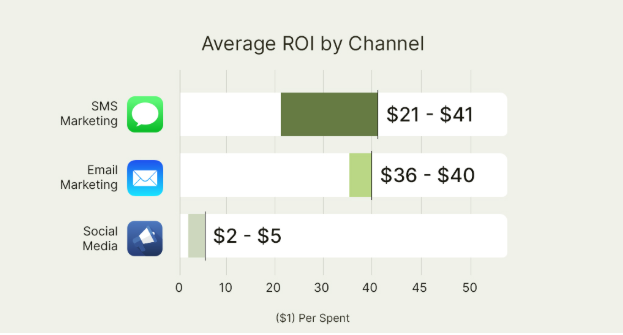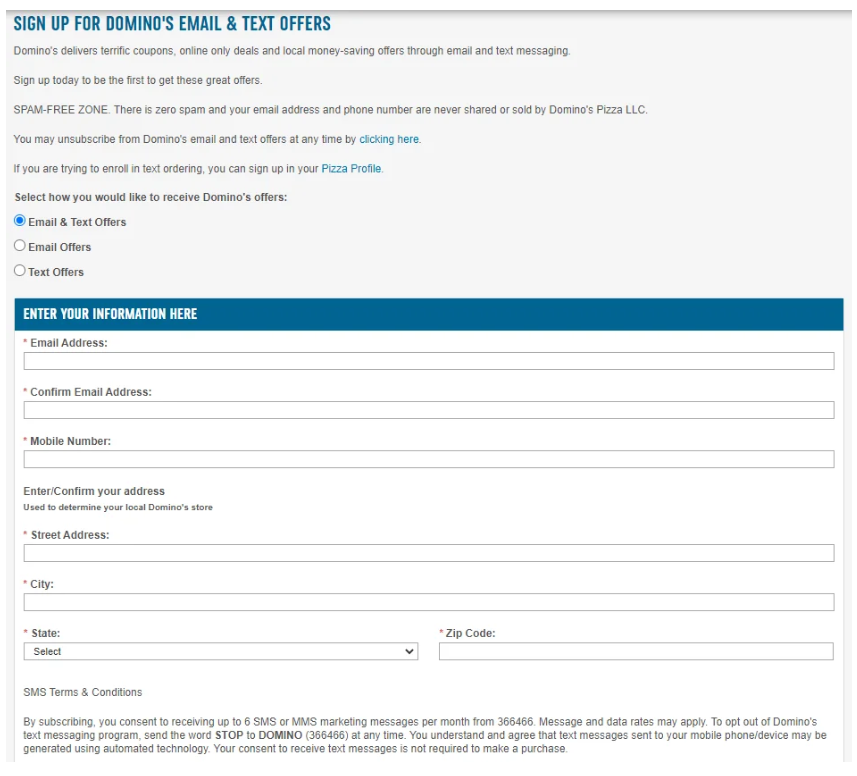Table of Contents
SMS marketing ROI helps you understand the real impact of the messages your brand sends—are they driving results or just noise?
What is SMS Marketing ROI ?
SMS marketing ROI goes beyond just being a metric. In simple words, it’s your clearest way to understand how much revenue your SMS campaigns are generating compared to how much you’re spending.
And when it comes to ROI in SMS marketing, every message counts.
For any business working with an experienced SMS agency, knowing how to track, understand, and boost your ROI is key. Today, let us break down what SMS ROI really means, how it’s calculated, and more importantly, how you can actively improve it using proven strategies from real brands.
What Is the Average ROI of SMS Marketing and Why It Matters for Your Business?
If you’re wondering whether SMS is truly pulling its weight in your marketing mix, let the numbers speak. SMS marketing ROI often falls between $21 and $41 for every $1 spent and in some cases, even higher.
But ROI isn’t just a figure you throw in a report. It’s your best lens into what’s working and what needs tweaking. The beauty of ROI in SMS marketing lies in how clearly you can measure it.
Let’s say you own a small online boutique. You send an SMS with a limited-time discount code to 1,000 subscribers. The cost of the campaign is $50. You generate 200 orders, with an average profit of $6 per sale. That’s $1,200 in profit from a $50 spend, which is a 2,300% return on investment. Not bad for a single text blast.
What makes SMS different is its immediacy. With 98% open rates and 18–30% CTR, your message is almost guaranteed to be seen and clicked within minutes. For time-sensitive offers, flash sales, or quick updates, it’s a high-impact, low-cost channel that drives measurable growth.
And while email still plays a key role in long-form communication and nurturing, many businesses working with an email campaign agency are now pairing email with SMS for stronger, more immediate campaign results.
SMS ROI Measurement: How to Calculate SMS Marketing ROI
Calculating your SMS marketing ROI doesn’t require advanced analytics tools or complex spreadsheets. It just takes a few simple steps.
Step 1: Measure Total Revenue from the Campaign
Start by identifying the direct revenue you get from your SMS campaign. This could be tracked using promo codes, custom short URLs, or sales tied to SMS-exclusive offers. Many businesses use campaign-specific landing pages to track these conversions more easily.
Step 2: Calculate Total Campaign Cost
Add up every dollar spent. This includes:
- Cost per message sent (usually between $0.01 and $0.05, depending on volume and provider).
- Platform fees (monthly subscriptions or per-campaign charges).
- Creative costs (copywriting, design, A/B testing tools if outsourced).
Even if the spend seems small, tracking it closely gives you an accurate text message ROI snapshot.
Step 3: Apply the ROI Formula and Calculate ROI
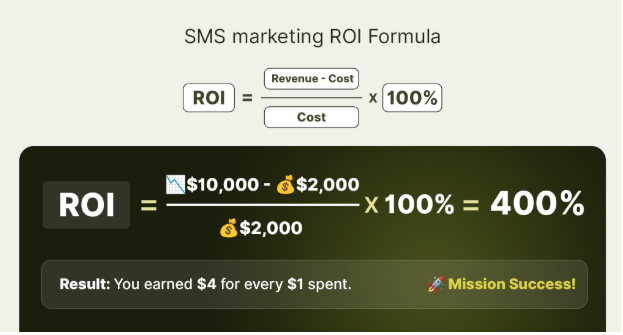
Let’s say you’re running a weekend clearance sale for your online apparel store. You send a text message with a 20% off code to 2,000 opted-in customers. The campaign costs you $150 in total, and this includes SMS delivery fees and your marketing platform’s flat rate.
Out of the 2,000 people, 180 customers made a purchase using the promo code. Your average profit per sale is $8. That means:
Total Revenue = 180 × $8 = $1,440
Campaign Cost = $150
Now plug those numbers into the formula:
ROI = (1440 − 150 / 150) × 100 = 860%
That’s an SMS platform marketing ROI of 860%, which is a clear sign that the channel is delivering strong returns. Plus, you now have data to support running similar campaigns during other seasonal sales or promotional windows.
Key Metrics to Track for SMS Marketing ROI
While revenue is the headline number, tracking the right supporting metrics can tell you why a campaign performed the way it did—and where there’s room to improve the ROI of SMS platform.
Here are some lesser-known, yet highly valuable metrics to monitor:
- Response time: The average response time to an SMS message is just 90 seconds. That means you’re engaging customers in near real-time.
- Engagement from personalized messages: Personalized SMS campaigns have been shown to deliver 6x higher engagement than generic blasts. Adding a name, relevant product info, or location-based detail can significantly boost your ROI.
- Deliverability rate: A high deliverability rate means your messages are reaching subscribers’ inboxes. Low rates may indicate outdated numbers or carrier filtering issues, both of which can hurt your overall SMS marketing ROI.
- Click-through rate (CTR): On average, SMS campaigns see CTRs around 18%, far outperforming email. This metric helps you gauge how compelling your message and call-to-action truly are.
- Conversion rate: While CTR tells you who clicked, conversion rate reveals who followed through. SMS conversion rates often range from 25–45%, especially when the message is timely, relevant, and paired with a mobile-friendly landing page.
- Unsubscribe rate: A low unsubscribe rate (typically under 1%) signals healthy engagement and a well-managed send frequency. Spikes in opt-outs are a red flag and should prompt you to review your messaging cadence and relevance.
Tracking these specific data points alongside sales gives you a holistic view of your campaign’s performance, as well as SMS marketing best practices, so you can get insights and improve accordingly. More importantly, it helps you spot patterns, fine-tune your approach, and build consistently better returns with every message sent.
How to Improve SMS ROI with Data
So you’ve sent out your SMS campaign, watched the clicks roll in, and calculated your ROI. But what do you do with that data?
Analysing your ROI is the roadmap to improving future performance. If you’re not turning those insights into action, you’re leaving money (and engagement) on the table. Here’s how to make your data work for you.
1. Segment ROI by Campaign Type, Not Just Overall Revenue
Not all campaigns are created equal. A flash sale SMS marketing campaigns will perform differently than a cart abandonment reminder or a loyalty offer. Instead of looking at your ROI data in one big chunk, break it down by campaign type.
For instance:
- Cart abandonment texts may generate fewer clicks but a higher average order value (AOV).
- Flash sales may get great engagement but lead to higher opt-out rates.
2. Match ROI With Engagement Data to Find the Sweet Spot
High ROI doesn’t always mean high engagement and vice versa. One campaign might deliver strong revenue but low click-through rates, hinting at a great offer paired with a weak call-to-action. Another might have high engagement but low conversions, suggesting your landing page isn’t converting traffic.
Use metrics like click-through rate, conversion rate, time-on-page, and bounce rate alongside your ROI to figure out where drop-offs happen and fix them.
3. Compare ROI Across Segments and Personalisation Levels
Personalised campaigns consistently perform better, but how much better? Track ROI separately for personalised vs. non-personalised SMS messages.
For example:
- “Hi Sarah, your skincare kit is back in stock” could have 30% higher conversions than “Our skincare sale is on.”
- Segmenting by past purchases or geography can lead to more targeted campaigns with higher SMS marketing ROI.
4. Review Timing and Frequency Patterns
One of the easiest wins in SMS marketing strategy is timing. ROI can vary wildly depending on when and how often you send messages.
Look at trends like:
- Which day of the week delivers the best revenue?
- What time of day gets the highest engagement?
- At what frequency do opt-outs start to rise?
Analysing this helps you time future campaigns for maximum impact and reduce fatigue, improving your overall ROI in SMS marketing strategy.
5. Assess Landing Page and Checkout Drop-off Rates
Sometimes, your SMS message does its job, but the customer experience falls apart after the click. If your ROI is lower than expected despite good engagement, investigate your landing page.
Is it mobile-optimised? Does it load fast? Is the checkout process smooth?
Heatmaps, funnel reports, and scroll-depth tracking tools can help you optimise the full journey, not just the message.
6. Track Cost Per Conversion, Not Just Revenue
It’s tempting to focus on total revenue, but don’t forget about efficiency. If one campaign generated $2,000 in sales but cost $500, and another generated $1,200 but only cost $100, the second campaign has the higher ROI.
Always calculate cost per conversion across campaigns and test lower-budget variations to maximise profitability.
7. Use ROI Insights to Build Smarter Automations
Once you know what types of SMS perform well, turn them into automated flows. For example, if birthday messages or “back-in-stock” alerts consistently show strong ROI SMS marketing results, automate them as part of your lifecycle campaigns.
This frees up your team’s time while making sure high-performing SMS messages are always in motion.
What Great SMS Marketing Looks Like: Industry Examples
When it comes to crafting high-performing SMS campaigns, some brands understand their customers, make the sign-up process frictionless, and use SMS in a way that adds real value, not noise.
Let’s break down what great text marketing campaigns look like in action.
1. Applebee’s: Seamless Order Updates Without the App
Not everyone wants to download yet another restaurant app. Applebee’s nailed this insight by offering customers the option to receive real-time text updates on their to-go orders without an app.
Once an order is placed online, customers get SMS notifications. When they arrive, a simple reply – “I’m here” – triggers staff to bring out their order. It’s low-effort for the customer and high-efficiency for the brand.
This strategy is convenient and quick and removes app fatigue, proving that SMS can improve customer experience while quietly boosting ROI SMS marketing through repeat use and positive brand perception.
2. Michaels: Building a List the Right Way
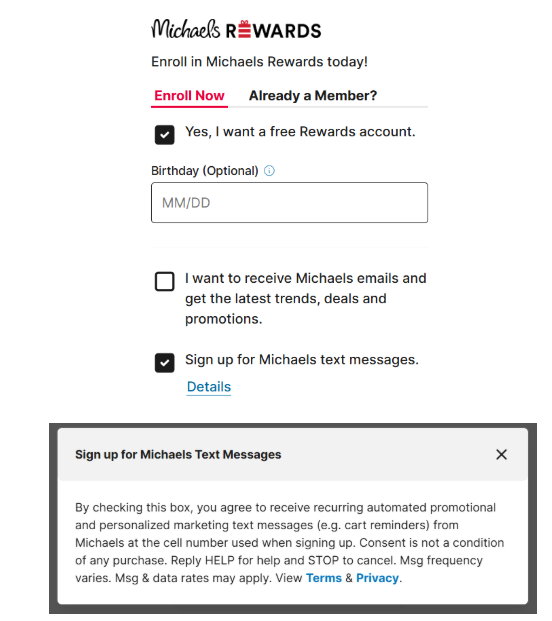
Arts and crafts giant Michaels takes a smart and simple approach to growing their SMS list. Instead of pushing it as a separate effort, they integrate SMS opt-ins directly into their online account creation flow.
New users can check a box to receive texts, and in return, they get access to promotions, creative inspiration, and seasonal trends.
Michaels earns ROI by collecting opt-ins during key moments of engagement (account creation), with clear consent and a clear value exchange.
3. Papa John’s: Using Keywords for Fast Deals

In the ultra-competitive pizza space, staying top of mind is half the battle. Papa John’s uses a classic keyword opt-in like texting “START” to a shortcode to deliver coupons and deals right to subscribers’ phones.
It’s fast, familiar, and works for busy customers looking for a quick deal without downloading or navigating anything complex.
4. Domino’s: Creative Meets Convenient
Domino’s took things a step further with their now-famous emoji ordering system. Customers could text a pizza emoji to place an order (yes, really). They also run a traditional SMS sign-up form that collects mobile numbers for discount alerts.
This proves that creativity can drive massive engagement. The emoji campaign boosted awareness, built their list, and offered clear attribution for ROI SMS marketing journey.
5. World Market: Driving Loyalty with Value-First Messaging
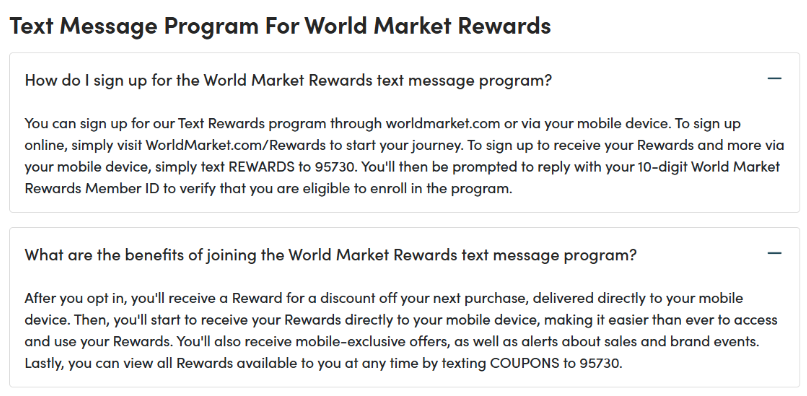
World Market ties its texting program directly to its free membership program. Members are encouraged to text a keyword and enter their ID to start receiving exclusive savings.
On their sign-up page, they clearly outline the perks, making it obvious why it’s worth staying subscribed.
Want to see more SMS marketing in action? Check out these powerful SMS marketing examples to get inspired!
Final Thoughts
At the end of the day, SMS marketing ROI is about building relationships, delivering timely value, and making every touchpoint count.
But like any powerful tool, it’s the strategy behind the message that determines the return. Brands that measure their performance, optimise based on real data, and invest in relevance not just reach but are the ones seeing the best results.
With proper tracking, segmentation, and creative execution, you’ll see measurable, repeatable gains in your ROI.
At InboxArmy, we help brands turn SMS into one of their most profitable marketing channels. From campaign strategy and segmentation to automation and analytics, our team delivers scalable solutions tailored to your goals.
Let’s work together to boost your SMS marketing ROI and start seeing real returns from every message you send.
Frequently Asked Questions About SMS Marketing ROI
Is SMS Marketing ROI really higher than email or social media?
In most cases, yes. Because SMS boasts open rates of 98%, with most texts being read within 3 minutes of delivery.
Compare that to email’s average open rate (around 18–20%) or the ever-changing algorithms of social media, and it’s clear SMS gets your message in front of customers faster and more reliably.
What is the SMS Marketing ROI Formula?
The formula to calculate SMS marketing ROI is
SMS ROI (%)= (Revenue – Cost/ Cost) × 100
How often should I evaluate ROI for SMS Campaigns?
Ideally, you should evaluate the ROI of SMS marketing performance after every campaign. However, for recurring campaigns or automated flows, reviewing ROI monthly or quarterly is more practical.
What is a good ROI for an SMS Marketing Campaign?
There’s no one-size-fits-all answer, but benchmarks show that businesses often see $21 to $40 in revenue for every $1 spent on SMS marketing performance. That’s a 2,000 4,000% ROI.
Is SMS Marketing illegal?
Not if done correctly. It’s legal when you get clear consent, include opt-out options, and follow regional laws like TCPA or GDPR. Staying compliant also improves list quality and boosts your SMS marketing ROI.







































